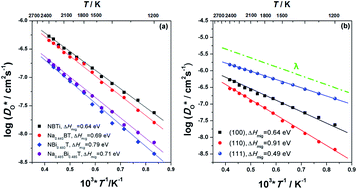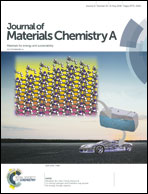Atomistic simulations of ion migration in sodium bismuth titanate (NBT) materials: towards superior oxide-ion conductors†
Abstract
Ion migration in Na0.5Bi0.5TiO3 (NBT) was investigated by molecular dynamics (MD) simulations and molecular static (MS) simulations. In MD simulations (>104 ions), performed for simulation times of tsim = 0.3 ns and at simulation temperatures in the range 1200 ≤ T/K ≤ 2400, oxide ions exhibited appreciable diffusivity, with derived activation enthalpies lower than 0.8 eV, whereas sodium and bismuth cations displayed no diffusion at the temperatures and on the time scale of the simulations. MS calculations yielded high activation barriers (>2 eV) for the migration of these cations. These results strongly suggest that the contribution of A-site cations to the total ionic conductivity is negligible. Bismuth vacancies and sodium vacancies were found to be detrimental to the rate of oxygen diffusion. The effect of ordered arrangements of Bi3+/Na+ cations on oxygen tracer diffusion was also examined by MD simulations. The (111)-ordered structure was seen to display higher rates of oxygen diffusion than the (100)- and (110)-ordered structures. MS calculations of the individual barriers for oxygen-ion jumps provided insights into this behavior. Our simulation results thus suggest design rules for developing superior low-temperature oxide ion conductors based on NBT perovskites and related materials.



 Please wait while we load your content...
Please wait while we load your content...